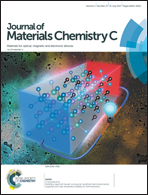Significantly improved electromechanical performance of dielectric elastomers via alkyl side-chain engineering†
Abstract
Dielectric elastomers (DEs) can be deformed in response to an electric field. Combining many muscle-like attributes like mechanical compliance, a very fast response, large actuation strain, a high energy density, noiseless actuation, and light weight, DEs are considered to be leading materials for “artificial muscles”. Herein, we report a new strategy to significantly improve the electromechanical performance of an elastomer by decreasing the chain entanglement density. A series of symmetric polystyrene–polyalkylacrylate–polystyrene triblock copolymers were synthesized using reversible additional fragmental transfer polymerization, where the chain entanglement density was varied by changing the bulkiness of the side groups of polyalkylacrylate. It is found that the voltage-induced maximum strain and energy density both quickly increase because the modulus is quickly decreased while the electric breakdown is little affected with an increase of the bulkiness of the alkyl side groups. The maximum actuation strain of polystyrene–poly(2-ethylhexyl acrylate)–polystyrene (SEHAS, 25% at 28 kV mm−1, without prestretch) and energy density (4.4 kJ m−3) are significantly higher than those of the state-of-the-art single component thermal plastic DEs. The actuation performance of SEHAS is comparable to that of the mammalian skeletal muscle. The other attractive attributes of SEHAS include thermal plasticity, relatively high tensile strength and a very low glass temperature (−68 °C) of the elastic phase.



 Please wait while we load your content...
Please wait while we load your content...